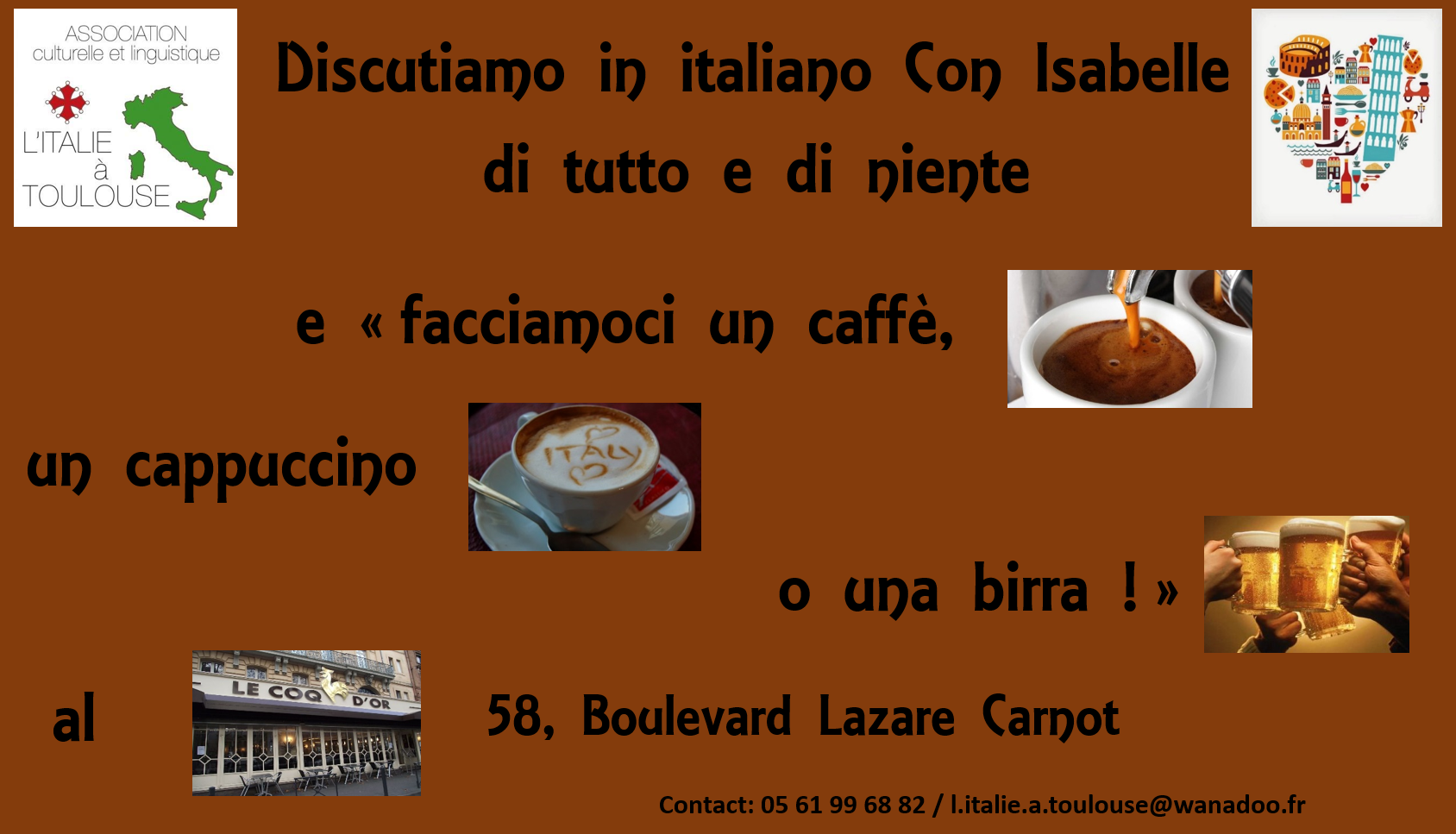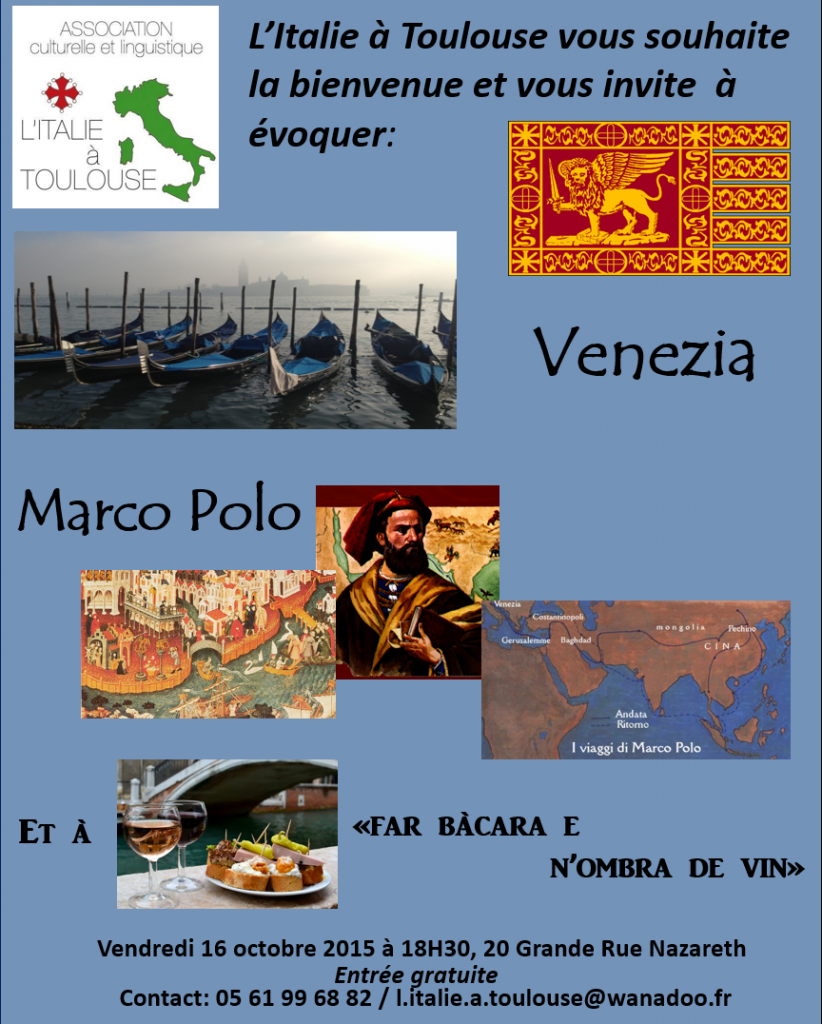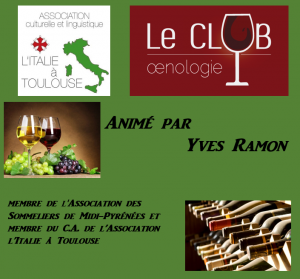In the context of "exhibition “the Empire of the color of Pompeii to the South of Gaul” in the Musée Saint-Raymond,
The Italy in Toulouse Association is pleased to offer you 2 guided tours in Italian.
In Italian
Tuesday 3 March 15:30
Thursday 12 March at 16:30
Visit guided lasts 1 h 15.

The exhibition The Empire of the color, Pompei in southern Gaul highlights the art of fresco at the time of ancient Rome and its resonance in southern Gaul, Cannes in Bordeaux.
Since the 19th century, the excavations at Pompeii helped to identify and list four major types of sets over a period of four centuries. These are the four "Pompeian styles.
The first Pompeian style, (2nd century - 80 av. our era) says style "of large appliance., inspired by Greek art and is characterized by stylized decorations. It is extremely rare in Gaul. Only Île Sainte Marguerite (Lérins Islands) provided fragments in stucco.
 Cannes, île Sainte-Marguerite (Lérins Islands), Royal Fort. Musée de la mer.
Cannes, île Sainte-Marguerite (Lérins Islands), Royal Fort. Musée de la mer.
The Pompeian second style (80-20AV. our era), is a trompe l'oeil decor divided into two styles :
-Schematic
-scenographic
The trompe l'oeil decor done artificially away the wall with false architectures, great landscapes or characters or theatrical world staged.
It is now the ornamentation of the walls that allows to give the illusion of depth !
This method of decoration is luxurious and is reserved for an elite.
Below, one of the rare examples : the large Villa of Boscoreale, near Pompei.
Four panels are exceptionally together and associated with a mock-up of the sumptuous Villa Glanum in Saint-Rémy-de-Provence.

Garland decor, tambourine and head of Bull Boscoreale (near Pompei), P Villa. Fannius Synistor.Amiens, Musée de Picardie

Model of the Villa of Publius Fabius Synistor . Royal Museum of Marienmont.
 Boscoreale, proposal of virtual restitution, from the North portico of the peristyle, of the oecus H. It is recognized, left of the entrance, the winged genius kept in the Louvre Museum (opposite). (Computer graphics J. Stanton-Abbott)
Boscoreale, proposal of virtual restitution, from the North portico of the peristyle, of the oecus H. It is recognized, left of the entrance, the winged genius kept in the Louvre Museum (opposite). (Computer graphics J. Stanton-Abbott)
 Trompe - the architectural eye Glanum, House of Sulla, Room D, triclinium. Saint-Rémy-de-Provence,Hôtel de Sade. Picture A. Barbet.
Trompe - the architectural eye Glanum, House of Sulla, Room D, triclinium. Saint-Rémy-de-Provence,Hôtel de Sade. Picture A. Barbet.
In Gaul, the second style adorns the walls of candelabras or mythological scenes.
The decorations are imitations of false marble.

Panel at the Dionysos, Villa de Roquelaure, Auch, Museum of the Jacobins in j.-f.. Peire
The third Pompeian style is an ornamental style in response to magic and to the Sham of the second style. The walls close and the decorations are simple.
These are sober, purified, often monochrome. These are huge yellow flat, black or red.
Candelabra, become columns vertical bands or delicate stalks of inspiration plant and metal dividing walls.


Tripods on black background of Boscotrecase-Boscotrecase (Campania), Villa known as "Agrippa Postumus", Black room (15). National Archaeological Museum of Naples.

This type of "candelabra walls" was extremely appreciated elites in Roman as Gaul attest to this certain decorations found in Aix-en-Provence (Domus of the area of the chapter) or in Périgueux (Domus Vésone).

Watercolour of Aix-en-Provence, representing a wall of the room 5 the Domus of the area of the chapter.
In the course of the 3rd style, the taste for paintings or decorative plaques, painted in the center of the panels, develop. They first occupy the central Panel then multiply on the side panels. This mode will culminate in the 4th style. The scenes represent rural or figurative views. The themes are idyllic or drawn from mythology.
 Heroic table Nîmes, Villa Roma, House 10, exhibit 2. Nîmes, Archaeological Museum
Heroic table Nîmes, Villa Roma, House 10, exhibit 2. Nîmes, Archaeological Museum
 Banquet scene, Pompeii Naples, MANN © Luigi Spina. Soprintendanza Speciale per i Beni Archeologici di Napoli e Pompei.
Banquet scene, Pompeii Naples, MANN © Luigi Spina. Soprintendanza Speciale per i Beni Archeologici di Napoli e Pompei.
– In Italy, the end of the 3rd style, in the years 20-30 a.d., is characterized by a gradual return of architectures and a certain conjuring inherited 2nd style.
-In Gaul, the back and forth of the Italian artists are more scarce. The Gallic workshops themselves and develop regional particularities to new and original compositions. Independence confirmed more and more in the second half from the 1st century a.d..
However, they will remain a long time influenced by the compositions of the style 3rd. Thence, probably can be explained the permanence of the 'candelabra style '..
The 4th Pompeian style goes from the reign of Claudius to the disappearance of Pompeii, i.e. 50 to 79 Apr. BC.
This style makes a return to the perspectives architectural and l’illusionism. It is a synthesis of both previous styles. Opening and depth effects
reappear. Ornamental taste remains with exuberant decorations, of gilding, the carvings, medallions, candelabras and reliefs in stucco.[]

Architectural decor, Naples Herculaneum, MANN. © Luigi Spina. Soprintendanza Speciale per i Beni Archeologici di Napoli e Pompei
The 4th style, as seen in Pompeii and elsewhere in Italy, has not been included in Gaul, except in Gallia narbonensis, due to its proximity to the Alps and the seniority of the implantation of Italian communities in the region. It seems to have been the more permeable Gallic province to Italian models.
This relative autonomy of provincial wall decor, compared to the Pompeian model, has led specialists of Roman painting to abandon the appellation 'fourth style' and to designate under the term of "painting Flavian" or "painting of the second half of the 1st century., the pictorial achievements found in Gaule.On also said "painting Flavian.. (The Flavian Dynasty : 69 – 96 AP. BC)

 Large candelabra and details Vienna (Isère), Street Pier. Archaeological Museum of Saint-Romain-en-Gal.
Large candelabra and details Vienna (Isère), Street Pier. Archaeological Museum of Saint-Romain-en-Gal.
The Toulouse exhibition thus presents a unique grouping of from paintings of the Gulf of Naples and frescos discovered in the South of the France, Cannes in Bordeaux. It is an illustration of the evolution of Roman painting since his appearance until the 2nd century a.d.. But it is also an unprecedented confrontation between Campania and the ancient Roman provinces of Narbonne and Aquitaine decorative patterns.
Facing the Italian «models» examples, allow, not only, highlight the "four Pompeian styles" but also to assess fidelity or even autonomy for decorative and ornamental patterns born at the centre of power (in the Urbs, Rome).
Thus, the influence of the painted decorations of Italy is clearly visible in the Roman provinces of Gallia narbonensis and Aquitaine. And then, Sets adapt to the requirements of owners and South of Gaul is little by little his own decorative way.
Parallel to these developments, the exhibition shows, by the return of a painted wall as well as by a film made for the occasion, the techniques used by the artisan of antiquity as well as contemporary restoration techniques of the painted decorations.
Pascal Capus, one of the two curators of the exhibition tells us why it is essential.
Here are three reasons :
- “Unique works. This is one of the few times where you can admire works lent by museums in Naples and Louvre. Total, the two institutions have brought in Toulouse 32 frescoes preserved so far in Italy or Paris and from the sites of Pompeii and Herculaneum, two Roman cities destroyed by the eruption of Vesuvius in 79 after JC. It is also a way to discover the heritage of the South of the France. South of the France paintings, Narbonne, Nîmes or Vaison la Romaine are also visible”.
- “Admire the Pompeian style. Between the 2nd century BC and the second half of the 1st century a.d., the Roman painters did evolve what specialists call the Pompeian style also found in the South of the France. First composed of a relief decoration of stylized, He then moved to décor in trompe l'oeil landscapes-based, of fictional characters or a theatrical universe. The villa of Boscoreale near Pompeii is one of the most striking examples: four panels met for the first time in France and it is Saint Raymond Museum. A model of villa is associated with these works to understand the context in which they were painted”.
- “Discover a replica of ancient painting. Aude Aussilloux and Maud Mulliez, two fresco, worked for seven months to create a fresco that one could find in antiquity. They manufactured themselves their brushes and tools to work on the visible panels at the Musée Saint Raymond. After studying the techniques of manufacturing used in antiquity during long months, they have created a painting with non-synthetic pigments”.
Interview with the dispatch to Pascal Capus, Curator of the exhibition :

Why this title 'the empire of colour '. ?
Pascal Capus : Because it is an exhibition on interior decoration in ancient times, covering three and a half centuries of murals, from the 1st century BC until the beginning of the 3rd century, through 79 tables, still lifes, fragments of walls. We see how there is 2 000 years, Rome, capital of the world, influenced fashion in decoration and that these trends were more or less followed to the South of Gaul, in the provinces annexed as Narbonne. In addition to painted plaster fragments preserved in the Museum Saint-Raymond, the exhibition benefits from outstanding loans from, among others, Pompei and the Louvre.
We say these murals on the tastes of the time ?
They show that tastes change, like today. All the 25/50 years, It broke the painted coverings and there were decorations. The rich Roman residence was very colorful, pretty bling-bling. One can imagine homes that were in full view with the marble, walls painted motifs, landscapes, mythological scenes or everyday life, enhanced color sculptures, mosaic floors. The typical example is the villa of Boscoreale, near Pompei, an American architect was the 3d reconstruction. It was a lavish home on the Gulf of Naples, who was buried under ash from Vesuvius to the 1st century. The remains were collected during excavations in the 19th century. We have the opportunity to present four panels together in France for the first time and associated with a model of the villa. These "models" are confronted with other coatings painted in the same style, found on the Gallo-Roman site of Roquelaure in the Gers.
Frescoes of Pompeii and Herculaneum in Toulouse, This is a first ?
Yes, and it is a huge privilege. We have negotiated these loans from the Archaeological Museum of Naples, who has agreed to make out 16 Works, for this first exhibition in France putting them into perspective Roman painting and its influences in Gaul.
What is for you the masterpiece of the exhibition ?
For me the absolute masterpiece is the winged genius of the Louvre, "Mona Lisa" of antiquity. This is the painting chosen for the poster of the exhibition. It comes from the villa of Boscoreale, where it was placed near a door. By far, We see a young man in the slightly dilated eyes, which looks fascinated as if he was fascinated by something that is happening outside. When we approach, It emerges that the character has wings in the back, pointy ears and a shaggy hair. It is a genius. This fresco was never out of the Louvre.
 1 Wednesday on 2 and 1 Friday per month.
1 Wednesday on 2 and 1 Friday per month.






















